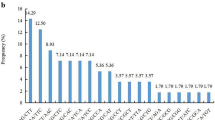Abstract
A recent approach to detecting genetic polymorphism involves the amplification of genomic DNA using single primers of arbitrary sequence. When separated electrophoretically in agarose gels, the amplification products give banding patterns that can be scored for genetic variation. The objective of this research was to apply these techniques to cultivated peanut (Arachis hypogaea L.) and related wild species to determine whether such an approach would be feasible for the construction of a genetic linkage map in peanut or for systematic studies of the genus. Two peanut cultivars, 25 unadapted germplasm lines of A. hypogaea, the wild allotetraploid progenitor of cultivated peanut (A. monticola), A. glabrata (a tetraploid species from section Rhizomatosae), and 29 diploid wild species of Arachis were evaluated for variability using primers of arbitrary sequence to amplify segments of genomic DNA. No variation in banding pattern was observed among the cultivars and germplasm lines of A. hypogaea, whereas the wild Arachis species were uniquely identified with most primers tested. Bands were scored (+/−) in the wild species and the PAUP computer program for phylogenetic analysis and the HyperRFLP program for genetic distance analysis were used to generate dendrograms showing genetic relationships among the diploid Arachis species evaluated. The two analyses produced nearly identical dendrograms of species relationships. In addition, approximately 100 F2 progeny from each of two interspecific crosses were evaluated for segregation of banding patterns. Although normal segregation was observed among the F2 progeny from both crosses, banding patterns were quite complex and undesirable for use in genetic mapping. The dominant behavior of the markers prevented the differentiation of heterozygotes from homozygotes with certainty, limiting the usefulness of arbitrary primer amplification products as markers in the construction of a genetic linkage map in peanut.
Similar content being viewed by others
References
Arnold ML, Buckner CM, Robinson JT: Pollen-mediated introgression and hybrid speciation in Louisiana irises. Evolution (in press) (1991).
Burkart A: Estudios sistematicos sobre las Leguminosas-Hedisareas de La Republica Argentina y regiones adyacentes. De Darwiniana 3: 117–302 (1939).
Caetano-Anolles G, Bassam BJ, Gresshof PM: DNA amplification fingerprinting using very short arbitrary oligonucleotide primers. Bio/technology 9: 553–557 (1991).
Futuyma DJ: Evolutionary Biology. Sinauer Associates, Inc., Sunderland, MA (1986).
Gregory MP, Gregory WC: Exotic germplasm of Arachis L. interspecific hybrids. J Hered 70: 185–193 (1979).
Gregory WC, Gregory MP, Krapovickas A, Smith BW, Yarbrough JA: Structures and genetic resources of peanuts. In: Peanuts-Culture and Uses, pp. 47–133. American Peanut Research and Education Association, Stillwater, OK (1973).
Halward TM, Stalker HT, LaRue EA, Kochert GD: Relative levels of genetic variation detectable with molecular markers among unadapted germplasm resources of cultivated peanut and related wild species. Genome (in press) (1991).
Kochert GD, Halward TM, Branch WD, Simpson CE: RFLP variability in peanut (Arachis hypogaea L.) cultivars and wild species. Theor Appl Genet 81: 565–570 (1991).
Smartt J, Stalker HT: Speciation and cytogenetics in Arachis. In: Patee HE, Young CT (eds) Peanut Science and Technology, pp. 21–49. American Peanut Research and Education Society, Yoakum, TX (1982).
Southern EM: Detection of specific sequences among DNA fragments separated by gel electrophoresis. J Mol Biol 98: 503–517 (1975).
Stalker HT: A morphological appraisal of wild species in section Arachis of peanuts. Peanut Sci 17: 117–122 (1990).
Stalker HT: A new species in section Arachis of peanuts with a D genome. Am J Bot 78: 630–637 (1991).
Stalker HT, Dhesi JS, Parry DC, Hahn JH: Cytological and infertility relationships of Arachis section Arachis. Am J Bot 78: 238–246 (1991).
Welsh J, McClelland M: Fingerprinting genomes using PCR with arbitrary primers. Nucl Acids Res 18: 7213–7218 (1990).
Welsh J, Peterson C, McClelland M: Polymorphisms generated by arbitrarily primed PCR in the mouse: application to strain identification and genetic mapping. Nucl Acids Res 19: 303–306 (1991).
Williams JGK, Kubelik AR, Livak KJ, Rafalski JA, Tingey SV: DNA polymorphisms amplified by arbitrary primers are useful as genetic markers. Nucl Acids Res 18: 6531–6535 (1990).
Author information
Authors and Affiliations
Rights and permissions
About this article
Cite this article
Halward, T., Stalker, T., LaRue, E. et al. Use of single-primer DNA amplifications in genetic studies of peanut (Arachis hypogaea L.). Plant Mol Biol 18, 315–325 (1992). https://doi.org/10.1007/BF00034958
Received:
Accepted:
Issue Date:
DOI: https://doi.org/10.1007/BF00034958



